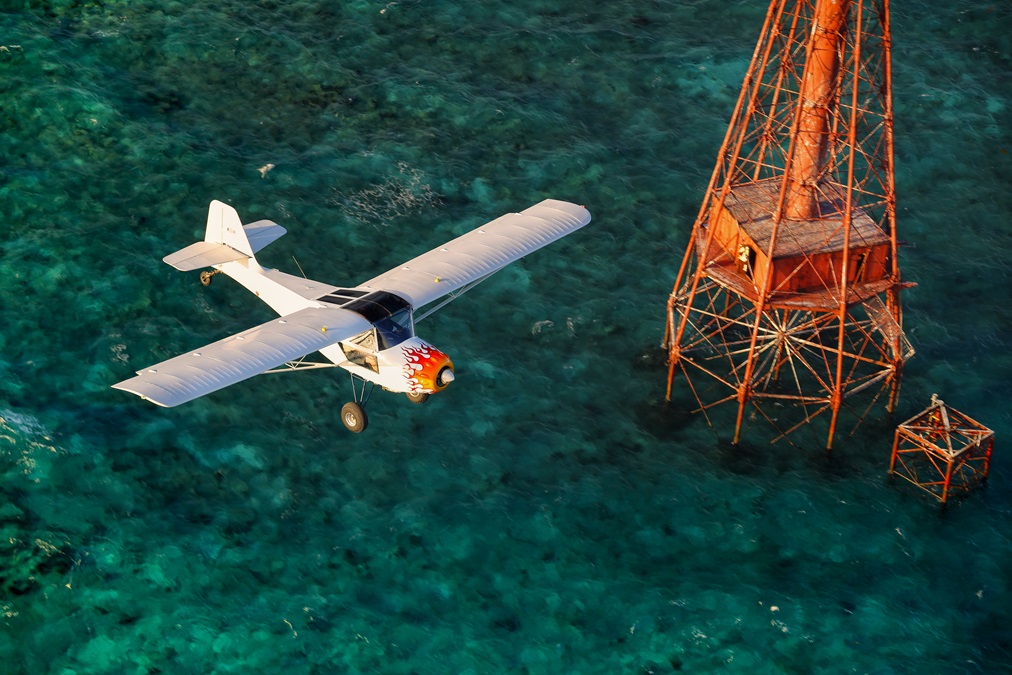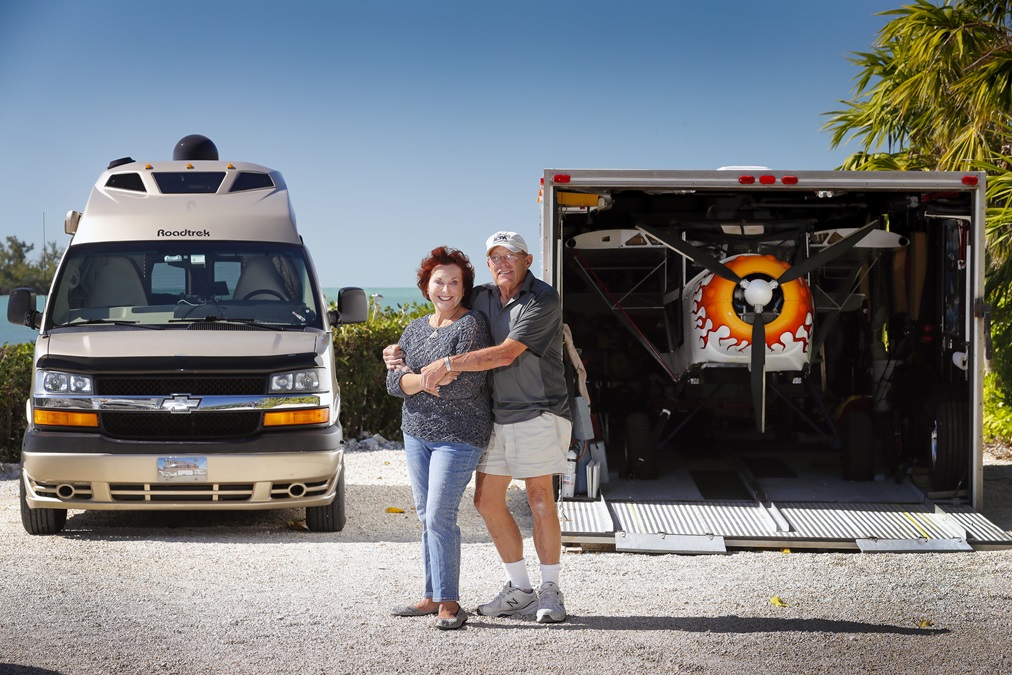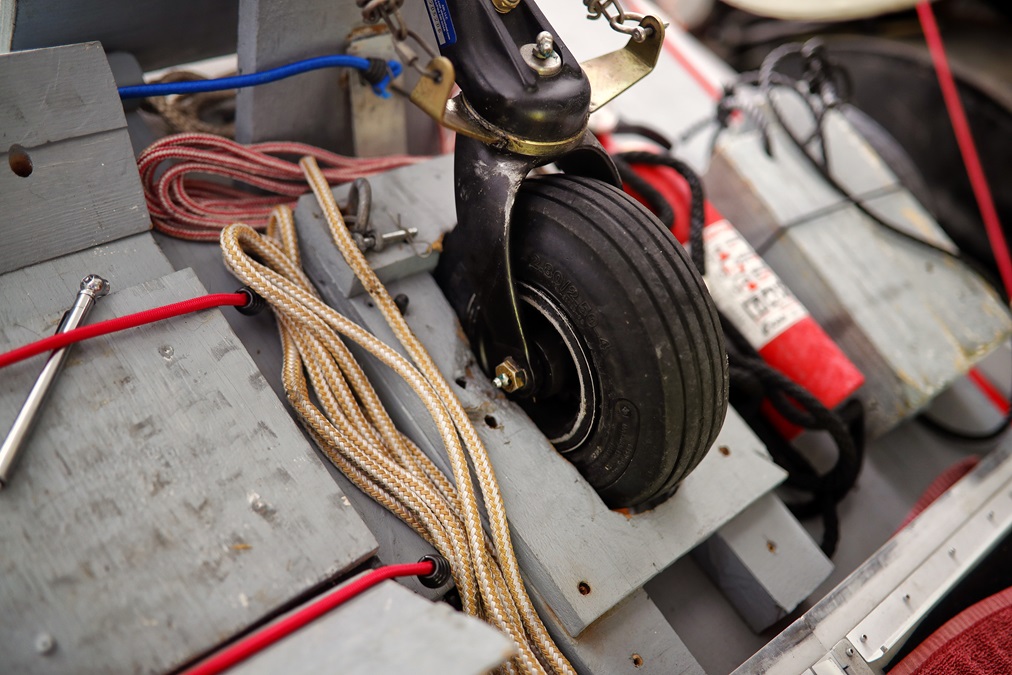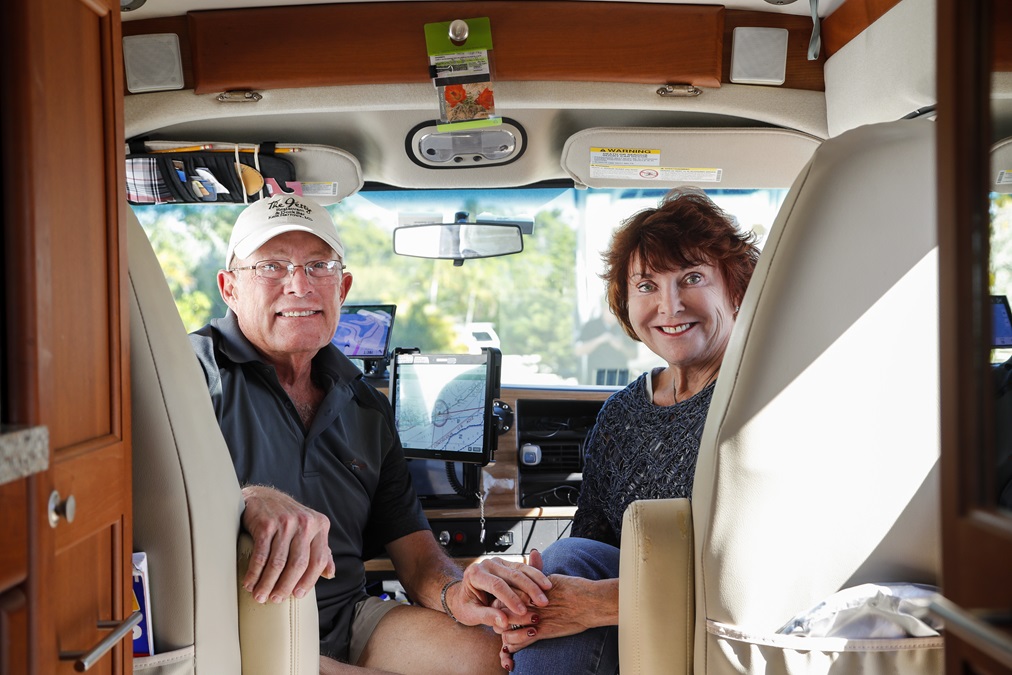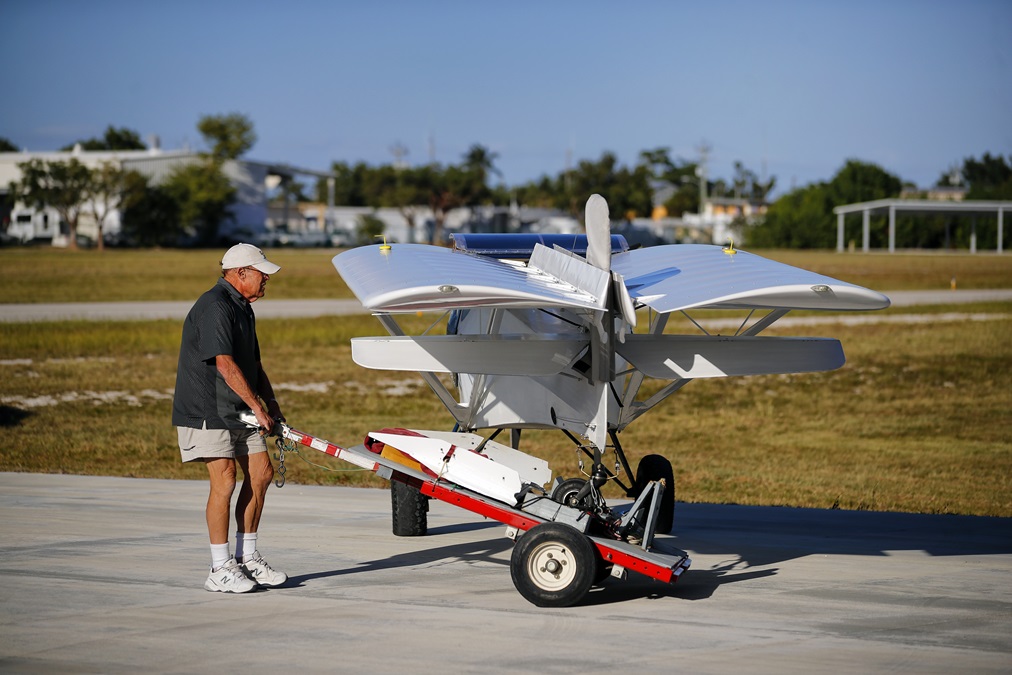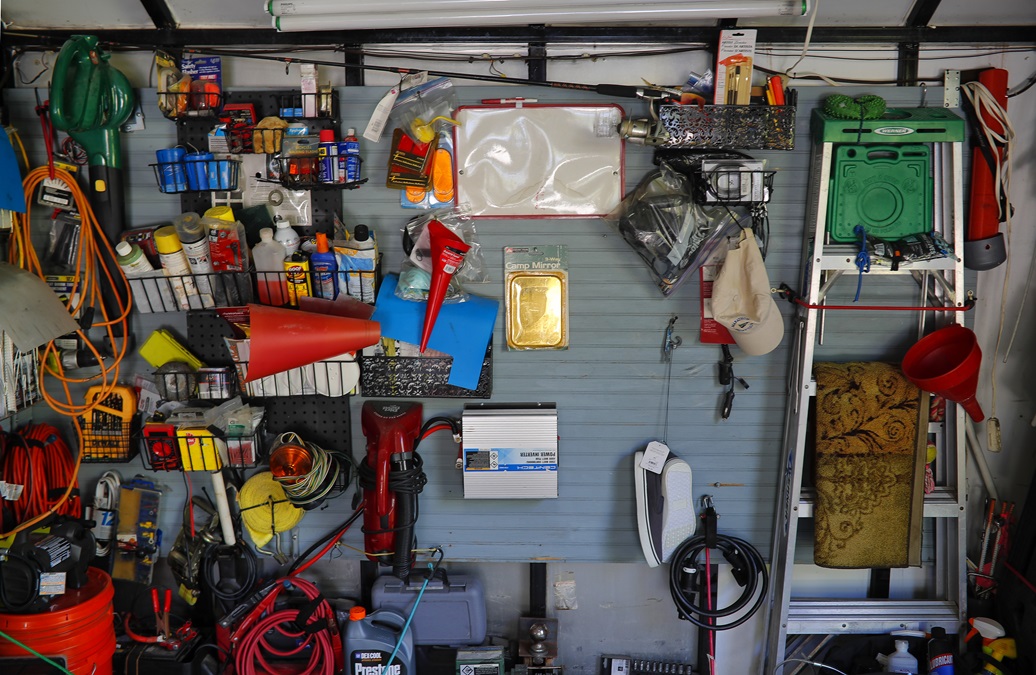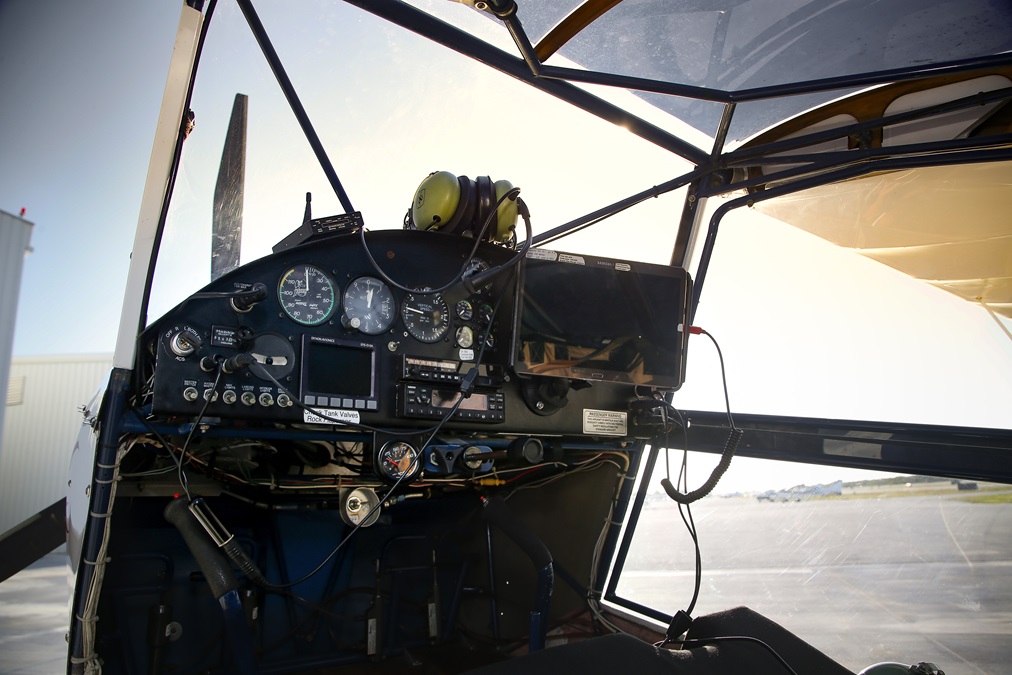Florida: Some assembly required
Who says a slow airplane can’t take you where you want to go?
The 50-foot trailer is white, and impossibly wide. It is nondescript, and looks like it could carry lawn equipment, or maybe an old car. Bob lowers the back gate and the propeller and blaze-orange flames on the cowling of his Kitfox 4 are facing us. Immediately you’re taken to your childhood. It looks like something you would have opened on Christmas and played with for hours.
It’s not entirely unusual to see an aircraft in a trailer. Gliders are often trailered, but those are tailor-made trailers and the wings come completely off the fuselage. A few Experimental and Light Sport manufacturers offer folding wings and a basic trailering setup. But even for those models that do offer folding wings, it’s unusual that someone uses the capability for anything other than keeping the airplane at their house near an airport. Bob and Dusti have put 100,000 road miles on theirs, despite the Kitfox people telling Bob, “It’s meant to be flown.”
The journey started with a declaration. Bob had just flown the Kitfox from Maryland to their winter house in the Florida Keys. The flight had been slow, but even for Jones, who is used to flying low and loitering, it was boring. “I’ll never do that again,” he said. And so began the quest for something better.
Jones loves the Kitfox, and calls it his Baby Plane. Getting rid of it wasn’t an option. So he decided to do what many have dreamt of doing before, but few have successfully accomplished. He folded the wings, and over many years he has developed a quick, safe, and secure trailering system. What began as a solution to the problem of getting his Kitfox back and forth between houses has blossomed into a complete overland touring system that has expanded the range of the little cruiser nationwide, and enabled Bob and Dusti to explore the United States from land and air.
Our love of airplanes sometimes makes facing their reality challenging. We try to pass them off as some sort of mechanical Swiss Army knife, capable of giving us utility, fun, and economy in one magical package. The reality is that no airplane does all things perfectly. But Jones has creatively taken an airplane meant for loafing and turned it into a versatile traveling machine, albeit with some Chevrolet-powered wheels as an aid.
A retired dentist and public health official, Bob has the mind of a tinkerer. He started with a wider-than-standard trailer to make it easier to get the airplane inside. The wings detach with a pin at the leading edge and pivot straight back, so the folded package is wider than you’d imagine. To easily get the airplane inside, he found a hand dolly at Harbor Freight Tools. On it he created a jig that holds the tail up and keeps weight off the tailwheel spring. There’s a slot to put the tailwheel inside. Jones can then easily pull the airplane in or push it out by the tail. Like trying to salvage a bad parallel parking job, you can imagine the back and forth required to line the Kitfox up correctly to get it in the trailer. Genius hack: cutting boards that can be placed under the wheels. Jones slides the mains left or right to get the correct alignment.

Since Bob and Dusti take it all over the country, he needed the Kitfox to be secure inside. The tailwheel trailer can be secured, which Jones only does when he knows the roads are going to be bumpy. The wings have a strong strut, but the factory provides additional supporting rods to hold up the tips while the wings are folded. Jones realized that it’s impossible to ratchet down the tires enough to hold the mains in place. He was lucky to find a Kitfox that was built with a float kit, so he attaches the front of the airplane to the rings in the floor through the float attach points.
Every piece of the trailer has been well considered. There’s foam on the walls where the leading edges would touch to ensure no contact. All the space around the airplane has been filled with tools, spares, and everything else needed to make a rolling shop. Jones defuels if the airplane is going to sit in the trailer for any length of time, so fuel cans sit in waiting as well. “It’s had the literal crap beat out of it and never suffered any damage, which I think means I got it right,” Jones said.
The next day the wind dies down and the genius of Jones’s arrangement comes into focus. When he’s at their house in the Keys, Jones tends to leave the trailer at home and tow the airplane down the street with the hand trailer. He drives through the back gate of the airport (a good relationship with the airport manager and FBO are a must, he says), and he can have the Kitfox from driveway to flyable in 10 minutes. The process is straightforward. The wings come forward and slide into a post in the leading edge. It takes only a simple bolt with a cotter pin to hold each one on. Then he attaches the ailerons and puts on the back turtle deck.
After a long taxi to the opposite side of the airport, our takeoff run is comically short. Despite being close to maximum gross weight, we are airborne and climbing like an elevator. Traffic pattern altitude comes close to the opposite end of the runway, and then we’re off to explore the islands.
With its high wing, slow cruise speeds, and clear plexiglass doors, the Kitfox is a superb airplane for enjoying the view. The water changes colors from lime green to navy blue, and we can pick out wrecks and their gashes through the coral, see giant turtles swimming in the sea, and gaze down at the beautiful homes.
This is not the kind of flying you can do in a Spam can. In fact, Jones owns a turbo Piper Twin Comanche that he previously used for business. Now it mainly sits in a hangar at the family’s Maryland summer home. Instead, he and Dusti spend between three and six months a year on the road exploring the country at 55 knots in the Kitfox.
Bob is practical with a side of literal. Dusti is fun-loving and tells great stories. When Bob describes why they chose Marathon as a winter base it’s simple and obvious—there is an airport and no control tower. Dusti rounds out the story: The first time they visited Marathon, Bob had just finished dental school. They strapped a tent and a few bags in to his Corvette and drove south from Maryland. They fell in love with Marathon and continued to go back, over the years flying the Twin Comanche and other airplanes down. The house and the Kitfox lined up in the early 2000s, and they’ve been coming back every year since.
When they’re on the road exploring other parts of the country, they often have rough plans to make certain stops by a certain time, but otherwise the journey is driven by what they find on Google—and maybe by an airport or location they want to see from the air. “It’s totally ad libbing it,” Jones said. “What could be more fun than flying whenever it’s perfect and beautiful?” Dusti said Bob is an early flier, often getting up and out of the van by 5 or 6 a.m. to go flying. Dusti prefers being a passenger in the evenings, after she’s worked all day (she owns a healthcare company and works from anywhere she can get a cellphone signal). She calls herself the Sleeping Wife. One of their favorite stops is Bangor, Maine, in part because the FBO has showers and they have a good rapport with staff. On one trip Dusti was on her way to use the shower. “I was kinda in my pajamas and the girl behind the counter said, ‘Oh you must be the sleeping wife.’” The nickname stuck.
The secret to a successful traveling partnership is that both enjoy the adventure. When Bob gives seminars at airshows on the rig he designed, Dusti is often the one getting the questions afterward. The setup makes it easy to accommodate both Jones’ needs: If Dusti needs to travel for work, Bob drops her off at an airport with airline service.
Early on he set up a cot in the trailer and told Dusti what a great time they could have traveling around, sleeping in the trailer. “It was better than a tent,” he said. “It looked like a hangar and smelled like a hangar, and I’m not sleeping in a hangar,” she said. That led to the search for a proper towing vehicle they could sleep in. The Chevrolet camper van has a shower, flush toilet, small kitchen, and large bed. It is large enough to sustain the two of them for months on the road, but small enough that they can unhook Baby Plane at the airport and use the RV as a car around town.
Jones used to rent airplanes while the family traveled, and although he had fun, there was always the concern of maintenance, the time required for the checkout, and all the other hassles that go along with renting. “Although I enjoyed doing that, it wasn’t nearly as good as driving that Baby Plane to the airport and taking it out on a beautiful day,” he said. The fun starts in 10 minutes.AOPA
Email [email protected]
